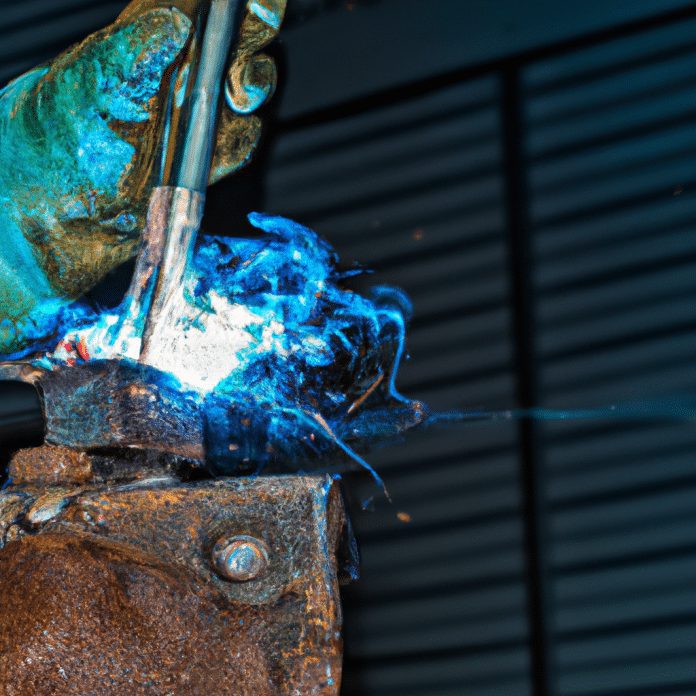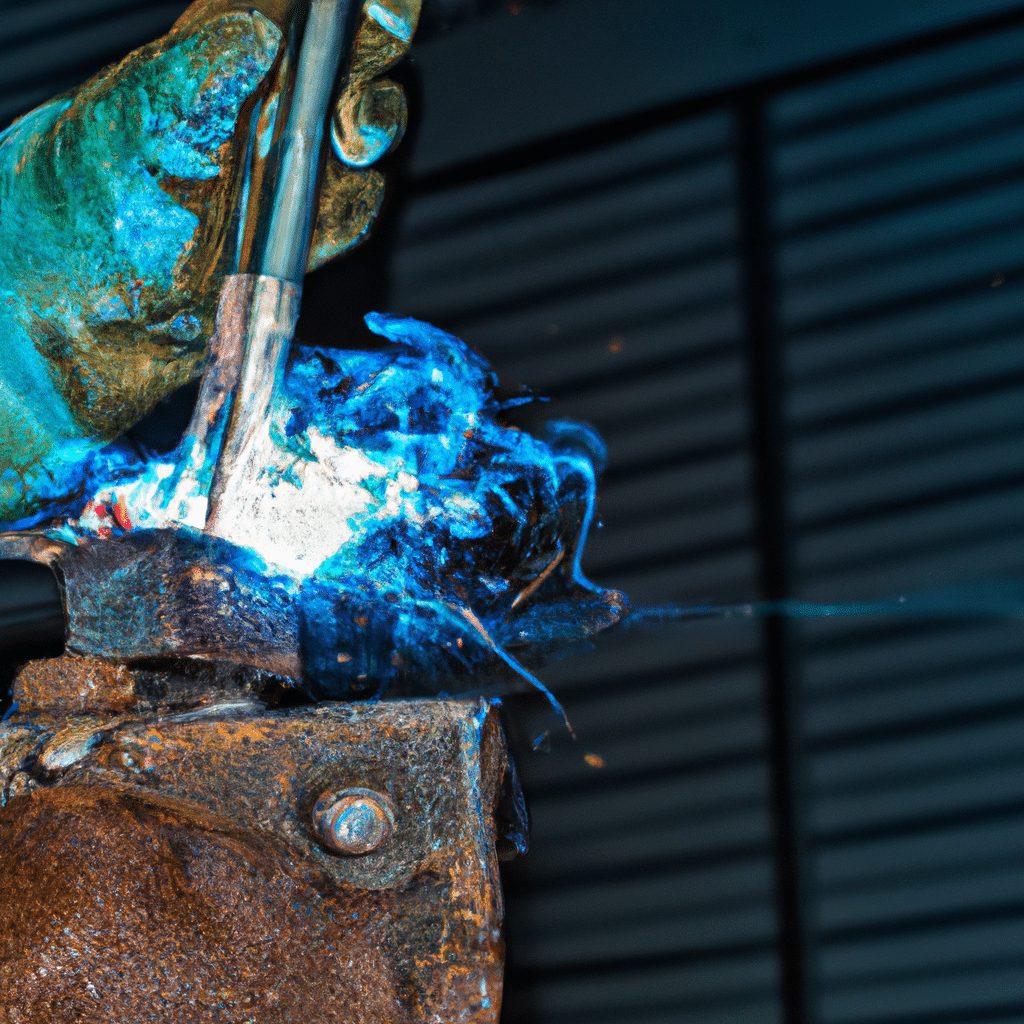In the world of welding, there is a tool that is revered for its versatility and invaluable assistance – the welding vice grip. This remarkable tool serves a singular purpose: to firmly hold, grip, and secure materials in place during the welding process. Whether it is metal sheets, pipes, or components that need to be joined together, the welding vice grip provides the stability and precision required for a seamless and successful weld. With its adjustable jaws and robust clamping mechanism, this indispensable tool ensures that the workpiece remains steadfast, allowing welders to focus their expertise on achieving flawless welds.
Review contents
What Is a Welding Vice Grip?
A welding vice grip is an essential tool used in various industries, particularly in metalworking and welding projects. It is a versatile clamping device that provides stability, precision, and control during welding and fabrication processes. With its adjustable design and sturdy construction, a welding vice grip allows users to securely hold and position workpieces, ensuring accuracy and efficiency in their work.
Definition
A welding vice grip, also known as a welding clamp or welding vise grip, is a mechanical tool designed to hold and secure objects in place during welding or fabrication tasks. It typically consists of two jaws, a screw or lever mechanism, and a handle for easy gripping and adjustment. The jaws of a welding vice grip are usually lined with heat-resistant rubber or metal to protect the workpiece from damage and prevent slippage.
Components
A typical welding vice grip consists of several key components that work together to provide the necessary clamping force and positioning capabilities. The two primary components are the jaws and the screw or lever mechanism.
The jaws of a welding vice grip are the parts that come into direct contact with the workpiece. They are responsible for securely holding the workpiece in place during welding or fabrication. The jaws are often lined with materials such as rubber or metal to protect the workpiece from damage and provide a firm grip.
The screw or lever mechanism is what allows users to adjust the clamping pressure and position of the jaws. In a screw-type welding vice grip, a threaded screw is turned to either bring the jaws closer together or move them apart. On the other hand, a lever-type welding vice grip uses a lever mechanism to achieve the same result with less manual effort.
The handle of a welding vice grip is designed to provide a comfortable grip for the user. It allows for easy operation of the screw or lever mechanism, making it convenient to adjust the clamping force and position of the jaws as needed. Some welding vice grips may also have additional features such as quick-release mechanisms for faster setup and removal.
Types
Welding vice grips come in various types, each designed for specific applications and requirements. The most common types include:
-
Locking C-Clamps: These clamps have a C-shaped design, with a screw or lever mechanism to adjust the jaw opening. They are versatile and can be used for a wide range of applications, making them a popular choice among welders.
-
Locking Pliers: Also known as Vise-Grip pliers, these tools offer a firm, adjustable grip using a quick-release lever mechanism. They are ideal for smaller workpieces or for situations where a larger welding vice grip may be too cumbersome.
-
G-Clamps: G-clamps, or bar clamps, have a distinct G-shaped design, with a screw mechanism that moves the jaw vertically. They are commonly used for woodworking and light metalworking tasks, providing a strong and stable grip.
-
Welding Magnetic Clamps: These clamps utilize magnets to hold the workpiece securely in place during welding. They are particularly useful when working with ferrous metals and offer quick and easy setup.
-
Pipe Welding Vise Grips: Designed specifically for welding pipes, these vise grips have adjustable jaws that can securely hold pipes of different sizes and shapes. They are commonly used in plumbing and industrial pipe welding applications.
Importance of Welding Vice Grip
Safety
Safety is paramount in any welding or fabrication project, and a welding vice grip plays a crucial role in ensuring a safe working environment. By securely holding the workpiece in place, it reduces the risk of slippage or movement during welding, which can result in accidents or injuries. Additionally, the heat-resistant lining on the jaws helps protect the workpiece from heat-related damage and prevents accidental burns to the user’s hands.
Accuracy
Achieving precise and accurate welds is essential for producing high-quality work. A welding vice grip provides the necessary stability and support to hold the workpiece in the desired position, allowing for accurate welds. The ability to adjust the clamping pressure and position of the jaws ensures that the workpiece remains firmly in place, even during intense welding processes.
Efficiency
Time is of the essence in any welding or fabrication project, and a welding vice grip helps increase efficiency by securely holding the workpiece in position, allowing the welder to focus on the welding process itself. It eliminates the need for constantly readjusting the workpiece, minimizing downtime and improving overall productivity. Additionally, the quick-release mechanisms on some welding vice grips enable fast setup and removal, further enhancing efficiency.
Applications of Welding Vice Grip
Metal Fabrication
Metal fabrication involves shaping, cutting, and welding metal pieces to create a structure or product. A welding vice grip is an invaluable tool in metal fabrication, as it securely holds the workpiece in place, allowing for precise cutting, shaping, and welding. Whether it’s creating intricate designs or constructing large structures, a welding vice grip ensures accuracy, stability, and efficiency throughout the fabrication process.
Automotive Repair
Automotive repair often involves welding tasks, such as fixing damaged frames, exhaust systems, or body panels. A welding vice grip is essential in these repairs, as it provides a secure hold on the workpiece while the welder performs the necessary welding tasks. The adjustable jaws make it easy to position the workpiece at the desired angle, ensuring accurate and effective welds.
Construction
In the construction industry, welding is commonly used for joining structural components such as beams, columns, and trusses. A welding vice grip is instrumental in these construction projects, as it allows for precise alignment and secure clamping of the workpiece during the welding process. Whether it’s installing metal frameworks or fabricating custom metal components, a welding vice grip ensures efficiency and accuracy in construction projects.
Choosing the Right Welding Vice Grip
Material
When choosing a welding vice grip, the material used in its construction is an important factor to consider. The jaws of the vice grip should be made of a durable material that can withstand high temperatures without warping or deforming. Steel or cast iron are commonly used materials for the jaws, as they provide excellent heat resistance and durability. Additionally, make sure the rest of the vice grip, including the screw or lever mechanism, is made from sturdy materials that can withstand the stresses of clamping and adjusting.
Size and Capacity
The size and capacity of the welding vice grip should match the requirements of the intended applications. Consider the maximum opening width of the jaws to ensure it can accommodate the thickness of the workpiece you typically work with. Additionally, pay attention to the maximum clamping force the vice grip can exert to ensure it provides sufficient stability for your welding projects. Choosing the appropriate size and capacity will ensure optimal performance and prevent any limitations or safety hazards.
Features
Different welding vice grips come with various additional features that can enhance usability and convenience. Some vice grips may include quick-release mechanisms, allowing for faster setup and removal of the workpiece. Others may have swivel jaws or extra-wide jaws for increased versatility. Consider your specific needs and the types of projects you commonly work on to determine which features would be most beneficial.
Proper Use of a Welding Vice Grip
Clamping Technique
Using the correct clamping technique is essential for ensuring the best results when using a welding vice grip. Start by positioning the workpiece between the jaws, making sure it is securely held in place. Gradually tighten the screw or adjust the lever mechanism, applying enough clamping force to hold the workpiece firmly but without causing distortion or damage. It is important to find the right balance between a secure grip and excessive pressure, as excessive force can lead to distortion or warping of the workpiece.
Avoiding Distortion
Distortion can occur during the welding process if the workpiece is not securely clamped in place. To minimize distortion, ensure that the welding vice grip is holding the workpiece firmly and that the clamping pressure is evenly distributed. Adjust the position of the workpiece if necessary to ensure a balanced clamping force. Additionally, consider using heat sinks or other techniques to help dissipate heat evenly and prevent localized distortion.
Maintenance
Proper maintenance of a welding vice grip is crucial to ensure its longevity and optimal performance. Regularly inspect the jaws and other components for signs of wear or damage. Clean the jaws and any exposed metal surfaces after each use to prevent the buildup of slag, spatter, or other debris that could affect the clamping ability. Lubricate any moving parts to ensure smooth operation and prevent corrosion. By properly maintaining your welding vice grip, you can extend its lifespan and ensure consistent performance.
Alternative Tools to Welding Vice Grip
C-Clamps
C-clamps are similar to welding vice grips in their clamping mechanism and versatility. They consist of a steel frame with a threaded screw mechanism used to adjust the jaw opening. C-clamps are commonly used in welding and fabrication projects, offering a strong and secure grip on workpieces. However, welding vice grips generally provide more precision and control, making them the preferred choice for many welders.
Locking Pliers
Locking pliers, or Vise-Grip pliers, are another tool commonly used in welding and fabrication tasks. They have a unique lever mechanism that allows for quick and easy adjustment of the jaw opening. Locking pliers are versatile and can be used for various applications, including clamping and gripping materials. However, they may not provide the same level of stability or precision as a dedicated welding vice grip.
G-Clamps
G-clamps, also known as bar clamps, are widely used in woodworking and light metalworking tasks. They have a distinctive G-shaped design, with a screw mechanism that moves the jaw vertically. G-clamps offer a strong and stable grip, making them suitable for holding workpieces securely during welding or fabrication. However, they may be less adjustable or versatile compared to welding vice grips, especially when working with larger or irregularly-shaped workpieces.
Safety Precautions When Using a Welding Vice Grip
Wearing Protective Gear
When using a welding vice grip, it is important to prioritize safety by wearing appropriate protective gear. This includes safety glasses or a face shield to protect your eyes from sparks, debris, and harmful UV radiation generated during welding. Additionally, welding gloves should be worn to protect your hands from burns, cuts, or other injuries. It is also advisable to wear flame-resistant clothing to minimize the risk of burns from molten metal or sparks.
Avoiding Overloading
Avoid overloading the welding vice grip beyond its recommended capacity. Excessive clamping force or attempting to hold workpieces that are too heavy or large for the vice grip can lead to failure or accidents. Always refer to the manufacturer’s guidelines and specifications regarding the maximum clamping force and capacity of the welding vice grip. If you need to work with larger or heavier workpieces, consider upgrading to a higher-capacity vice grip or using alternative clamping methods.
Securing Workpiece
Before starting any welding or fabrication task, ensure that the workpiece is securely clamped in place using the welding vice grip. Double-check that the jaws are tight and holding the workpiece firmly. Avoid working with workpieces that are loose or could potentially slip during welding, as this can cause accidents or damage to the workpiece. Regularly inspect the clamping force during welding to ensure it remains secure, especially when high temperature or vibration may affect the grip.
Common Mistakes When Using a Welding Vice Grip
Incorrect Clamping Pressure
Applying the wrong clamping pressure is a common mistake when using a welding vice grip. Insufficient clamping pressure can result in slippage or movement of the workpiece during welding, leading to inaccurate welds or potential safety hazards. Conversely, excessive clamping pressure can cause distortion or damage to the workpiece. It is important to find the appropriate balance between a secure grip and excessive pressure, taking into account the material and thickness of the workpiece.
Neglecting Cleaning and Lubrication
Neglecting to clean and lubricate the welding vice grip can affect its performance and durability. Slag, spatter, or other debris can build up on the jaws and impede the grip, reducing its effectiveness. Regularly clean the jaws and any exposed metal surfaces, removing any debris or contaminants. Lubricate any moving parts to ensure smooth operation and prevent corrosion. By regularly cleaning and lubricating your welding vice grip, you can maintain its optimal performance and extend its lifespan.
Misalignment
Misalignment of the workpiece within the welding vice grip is another common mistake. Improper alignment can lead to uneven clamping pressure, resulting in distortion or inaccurate welds. Take the time to position the workpiece properly between the jaws, ensuring it is centered and evenly supported. Adjust the position of the workpiece if necessary to achieve a balanced clamping force. Proper alignment will help prevent potential issues and improve the quality of your welds.
Tips and Tricks for Welding with a Vice Grip
Using Vice Grip as Heat Sink
A useful tip when welding is to utilize the welding vice grip as a heat sink. Certain types of welding may generate excessive heat, causing distortion or warping of the workpiece. By clamping the vice grip close to the welding area, it can absorb and dissipate some of the excess heat, reducing the risk of distortion. This technique is particularly effective when working with thin or heat-sensitive materials.
Using it as a Third Hand
A welding vice grip can serve as a valuable “third hand” when working on complex or intricate welding projects. By securely clamping one end of the workpiece, it frees up both hands to manipulate the welding torch and filler material. This allows for better control and precision during the welding process, improving the overall quality of the welds. Utilizing the welding vice grip as a third hand can also help reduce fatigue and minimize the risk of accidents.
Clamping Techniques for Different Welds
Different welding techniques require specific clamping techniques to achieve the desired results. For example, when performing a T-weld or a corner weld, positioning the workpiece at a right angle and securing it with the welding vice grip ensures accurate alignment and stability. On the other hand, for butt welds or lap welds, properly aligning the workpiece and clamping it securely with the vice grip along the joint ensures a tight fit and prevents any movement during welding. Familiarize yourself with the recommended clamping techniques for different welds to achieve optimal results in your welding projects.
Conclusion
In conclusion, a welding vice grip is an indispensable tool in various welding and fabrication projects. Its purpose is to securely hold and position workpieces, allowing for precise and accurate welds. By providing stability, safety, and efficiency, a welding vice grip plays a crucial role in ensuring the success of welding tasks. The proper selection and use of a welding vice grip, along with adherence to safety precautions, can greatly enhance the quality, productivity, and safety of welding and fabrication projects. So, whether you’re working in metal fabrication, automotive repair, or construction, a welding vice grip is a valuable tool that should not be overlooked.





























